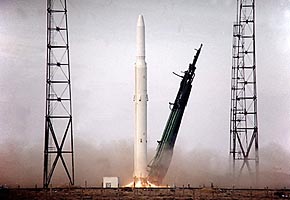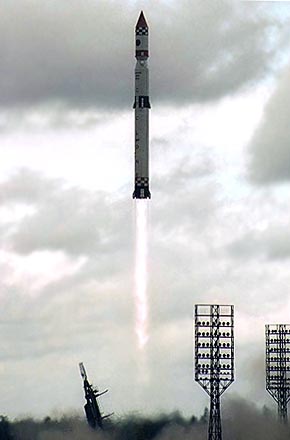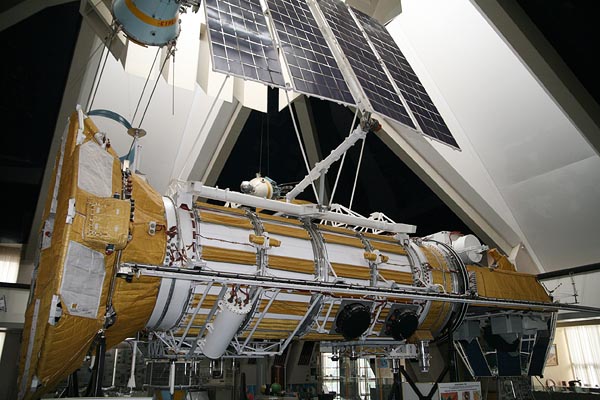Ukrainian Space Activities and IndustriesLaunch of Zenit3 from Oddessy PlatformCourtesy of NASU National Space Agency of Ukraine, Kiev2006-07(C) Seiji Yoshimoto  Major Cities of Ukrainian Space Industries |
Ukrainian Space Industrieshave been playing very important roles in space activities in the world. Today nearly 20% of space launches in the world are by using rockets made in Ukraine, such as Zenit, Cyclone and Dnepr. National Space Agency of Ukraine (NSAU)was established in February 1992 in order to implement state space activities policy after the disintegration of USSR. About 30 production enterprises, research organizations and design offices are in the contol sphere of NASU.The high performance and high reliability technology of Ukrainian rockes is based on a large amount of theoretical and experimental works on the dynamics of rockets accummulated during past 50 years. Another important advantage of Ukrainian Space Industries is their cost effectiveness due to low living and labor cost in major industrial areas in Ukraine.
|
|||||||||||||||||||||||
The History of Ukrainian Space Industry starts back in 1937 when a team of scientists from Kharkov Aviation Institute lead by Georgy Proskura launched a large stratospheric rocket near Kharkov.1950'sIn 1951 a large automobile plant "Machine Building Plant" in Dnepropetrovsk in central Ukraine was renamed as "Machine-Building Plant No. 586" and started to produce SS-1 (R-1), SS-2 (R-2) and SS-3 (R-5M) missiles. Three years later, "Special Design Office No.586," headed by Michael Yangel, was established and developed SS-4 (R-12), a new generation of missile with advanced combat performance. The SS-4 was the first strategic missile that used storable-fuel components and autonomous guidance system. Based on the SS-4, a Cosmos satellite launch vehicle (SL-7) was developed in 1957. Cosmos eventually became the primary launch vehicle in the Soviet Union until 1977 and launched 140 satellites.
|
||||||||||||||||||||||||
 SS-7 (R-16)Courtesy of SDO Yuzhnoye  Cyclone-2 (SL-10/11)Courtesy of SDO YuzhnoyeCyclone-3 (SL-14)Courtesy of YuzhnoyeSS-9-3 (R-36)Courtesy of SDO Yuzhnoye  Intercosmos Launch Vehicle (SL-8)Courtesy of SDO Yuzhnoye   KhartronCourtesy of NSAUDS-U2 SatelliteCourtesy of SDO YuzhnoyeDS-2 Satellite (Cosmos-1)Courtesy of SDO Yuzhnoye Intercosmos Satellite2006-07 (C) Seiji Yoshimoto |
1960'sIn order to develop the missile's control system OKB-692 was established in Kharkov. The OKB-692 was later renamed “Khartron”. Ukrainian space industry developed and produced control systems, on-board equipment, for spacecraft and launch vehicles. The Machine-Building Plant no. 586 was later renamed "Yuzhny Machine-Building Plant" and the Special Design Office was later designated as "Yuzhnoye State Design Office" or "SDO Yuzhnoye." SDO Yuzhnoye developed a SS-5 (R-14) strategic missile and the first Inter Continentall Balistic Missile (ICBM) SS-7 (R-16) using high-boiling-point propellant UDMH enabling fully loaded long-term stay. The SS-5 was the basis for the SL-8 Intercosmos launch vehicle that successfully launched 1000 satelltes or other payloads and even currently launches satellites from the Kapustin Yar and Plesetsk sites.
SDO Yuzhnoye started to develop spacecraft. The first Dnepropetrovsk-made satellite DS-2 was launched into orbit in 1962 and named Cosmos-1. Yuzhnoye continued to develop a series of Little Unified Earth Satellites for scientific research. Totally about 50 satellites were launched. Yuzhnoye initiated an international space program called "Intercosmos", and its first satellite Intercosmos-1, was launched in 1969. |
|||||||||||||||||||||||
|
|
||||||||||||||||||||||||
1980'sCosmos-1500 satellite was launched with an on-board side looking radar. Ocean satellites were designed for remote earth sensing and world ocean research, and their launches began in the early 80's. Zenit-2LV(SL-16) with nontoxic propellant was successfully launched. Railway-based launch ICBM SS24 and latest version of SS-18 (R-36M2) were developed. At the end of the 80's space and rocket technologies were in demand in civil sectors of the national economy of the USSR. |
||||||||||||||||||||||||
1990'sThe disintegration of USSR at the end of 1991 impacted Ukrainain Space Industry seriously. The budget for rockets and satellites decreased drastically, and the space industry had painful restructurering. About half of empoyees had to leave, and the remaining specialists started civil projects such as production of electric buses and wind electric power generators. Ukrainian space industry was on the way of recovery in the second half of 90's by coverting militaly technology for international commercial applications. Major achievements in the second half are:
|
||||||||||||||||||||||||
Exhibition of Ukrainian Space Industries at Aviasvit 20102010-10 (C) Seiji Yoshimoto 2010-10  Exhibition of Ukrainian Space Industries at Aviasvit 20102010-10 (C) Seiji Yoshimoto 2010-10Exhibition of Ukrainian Space Industries at Aviasvit 20102010-10 (C) Seiji Yoshimoto 2010-10 Exhibition of Ukrainian Space Industries at Aviasvit 20102010-10 (C) Seiji Yoshimoto 2010-10 Exhibition of Ukrainian Space Industries at Aviasvit 20102010-10 (C) Seiji Yoshimoto 2010-10 Exhibition of Ukrainian Space Industries at Aviasvit 20102010-10 (C) Seiji Yoshimoto 2010-10 Exhibition of Ukrainian Space Industries at Aviasvit 20102010-10 (C) Seiji Yoshimoto 2010-10 Exhibition of Ukrainian Space Industries at Aviasvit 20102010-10 (C) Seiji Yoshimoto 2010-10 |
||||||||||||||||||||||||
This page is prepared by NPO InterCoS with special courtesy National Space Agency of Ukraine, Yuzhnoye State Design Center, and ISC Kosmotras.
|
||||||||||||||||||||||||









.jpg)








